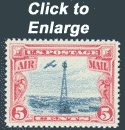Once you've been bitten by the collecting 'bug' and spent a few years building you're collection with the standard catalog numbers, most of us start to look for something more…more unusual…more interesting. In the trade we call it 'Fly Spec' Philately. By definition, this is the hunt for the more elusive and esoteric varieties of the plain vanilla catalog numbers. These include plate varieties (plate flaws), color errors (color missing, incorrect colors, inking errors, etc.), perforation varieties (perfing varieties, imperfs, part perfs, etc.), paper varieties, watermark errors and a host of other interesting oddities.
Many of the more affluent collectors choose to begin with the listed INVERTS, COLOR MISSING Errors, and the like. This is great if you can afford it!!!!! Very few of us can spring for a C3a or 295a. However, it can be just as much fun when you find one of the little gems that may not be listed in Scott's Standard Postage Catalog, but represents an example of some of the varieties listed above. The hunt can be fun, challenging, and quite rewarding when you finally find your Holy Grail. It does NOT have to cost much to satisfy that deep craving we all get as stamp collectors. It's the QUEST, the achievement, the feeling of accomplishment. It's especially fulfilling though when you can get it from a Stamp Dealer without him even knowing what it is. Now, that's fulfillment in spades!
While not divulging my age, I began collecting in 1957 as a ten year old. Whoops, the cat is out of the bag. Oh well, in today's world, I'm a stamp youngster. Anyway… my father gave me his childhood collection, which wasn't all that much, but it did have a few nice stamps. There were quite a number of Airmails and many front-of-the-Book issues back to 1930. He did have a mint Baby Zepp (C18) and some other less expensive items. Not having a catalog at first, I marveled at the stamps and the fact that my father had just given me a fortune (it didn't take much back in those days). But after going over the collection, my dad gave me some sage advice. He told me "start at the front of the book with US#1 and work from there. Don't do like most kids and just buy the items out of the Post Office. Study the history surrounding each stamp and why they were issued." Seemed like the right way to approach things in my ten-year-old unfettered mind. Note. this was almost before TV and certainly before MTV, video games, PC's and the like. Just good 'ole fashioned STAMP COLLECTING.
Getting back to my 'treasure trove,' I spent many hours studying, sorting, and pondering these interesting pieces of history. One stamp that caught my eye was the Beacon Airmail (C11). It was fascinating and it looked obviously very valuable to me. I put it aside for further study. Some weeks later, my dad seeing that I was taking to this hobby like 'Grant took Richmond,' gave me the most recent issue of H.E. Harris & Co's United States Retail Stamp Catalog. Wow, talk about opening up a new world. I buzzed through it immediately looking for the value of my pride and joy C11. Talk about being CRUSHED… my jaw dropped when I saw that it was listed at about 15 cents. "How can this be?" I pondered. It looks very old and surely there must be a mistake here. "No," my father explained. "It is the law of 'Supply and Demand', too many stamps and not enough people want them." One of my first lessons in microeconomics was a doozie. "Oh well," I thought. Maybe if a dig deeper, someday I might find something more than meets the eye.
I lived in Miami, Florida, at the time and became a 'regular' at Abott Hobbies in Downtown Miami. This was not an easy commute since it was about 15 miles from my house. But, being the phila-addict that I was, no distance was too far for me and my Schwinn. About an hour and a half through a trillion side streets and I was there, my Saturday fix soon to be satiated. The kindly proprietor there spent countless hours showing me stamps, educating me on how to examine them and introducing me into the world of 'Flyspec Philately'. Wow, a new vista that only I, amongst all my collecting buddies, would have a head start. But, where would I begin? I asked my Abott Hobby mentor. He said, "What stamp really interests you?" I piped up that the Beacon Airmail has always been my favorite (always being about 6 months anyway!). Boy, that was all I needed to say. My mentor said this was my lucky day. He proceeded to bring out a stock book with hundreds of mint and used copies of C11. He urged me to go though each and every one and see if anything seemed unusual and to make a pile of them and we would go over them together. Well… this was a great way to spend a Saturday  afternoon. I spent three hours mulling over this hoard and had two piles at the end. The C11 has two colors, carmine and blue and I noticed that the blue 'center' design seemed to more around within the carmine frame from stamp to stamp. Some higher, some lower, some to the left, some to the right. I was on to something here! I called to my friend Bob who owned Abotts. He looked at my work and said, "Good boy, but you missed something." I shook my head and asked what had I missed?
afternoon. I spent three hours mulling over this hoard and had two piles at the end. The C11 has two colors, carmine and blue and I noticed that the blue 'center' design seemed to more around within the carmine frame from stamp to stamp. Some higher, some lower, some to the left, some to the right. I was on to something here! I called to my friend Bob who owned Abotts. He looked at my work and said, "Good boy, but you missed something." I shook my head and asked what had I missed?
 Lesson two- he asked me to study the 'derrick shack' at the bottom of the Oil Derrick in all 200+ copies he had given me. What else did I have to do as a 10 year old, fight a war? No!….just dig in and check this mystery out. Forty-five minutes later I had the answer. On 3 copies I found that the 'Door' on the derrick shack was white and not fully colored in with blue. Bob said I had done a very good job in finding the 'Open Door' variety of the Beacon Airmail Issue. He explained that this was an underinking in the door area caused by a 'clogging' of that deeply engraved area. Very interesting, and to my delight, Bob gave me one of the examples for FREE.
Lesson two- he asked me to study the 'derrick shack' at the bottom of the Oil Derrick in all 200+ copies he had given me. What else did I have to do as a 10 year old, fight a war? No!….just dig in and check this mystery out. Forty-five minutes later I had the answer. On 3 copies I found that the 'Door' on the derrick shack was white and not fully colored in with blue. Bob said I had done a very good job in finding the 'Open Door' variety of the Beacon Airmail Issue. He explained that this was an underinking in the door area caused by a 'clogging' of that deeply engraved area. Very interesting, and to my delight, Bob gave me one of the examples for FREE.
If you too would like a little spice, try to find one of the 'Open Door' varieties of the Beacon Airmail. There are several variations of this variety, too. As this area of the plate grew more and more clogged, the 'Door' area got more and more white - from the door merely 'cracked' all the way to the door fully 'Open'.
I hope that this gives you an idea how to 'spice' up your collection, too!